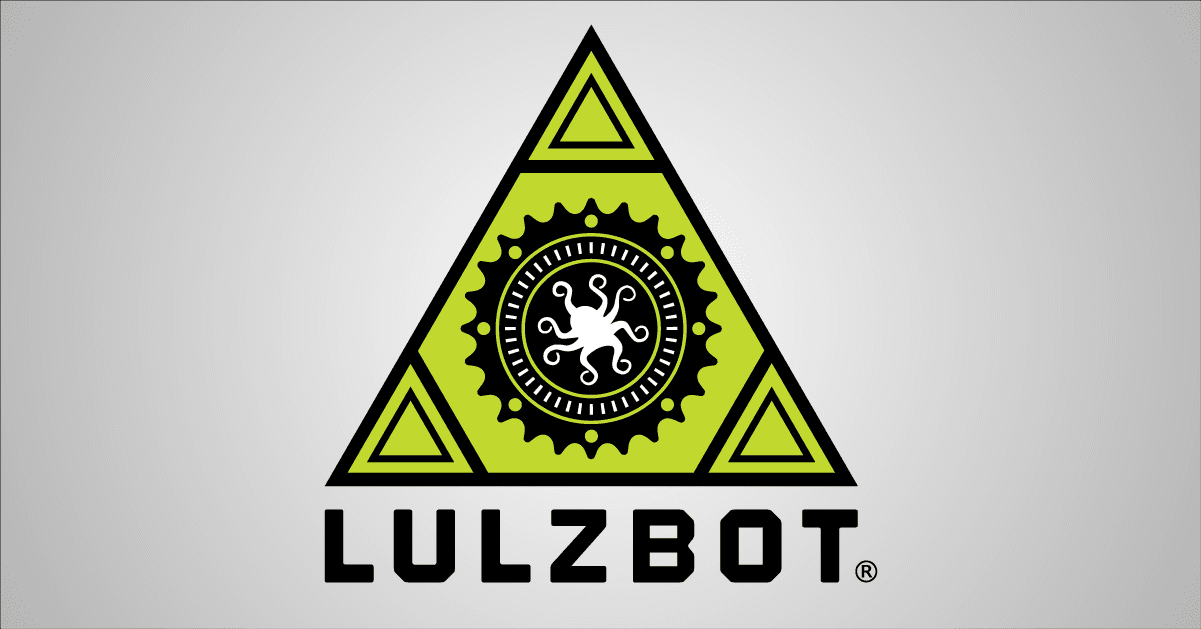We recommend using Cura LulzBot Edition to prepare your digital models for 3D printing. Cura LulzBot Edition includes preset slicing profiles for over 300 filament, tool head, and quality options.
Some customizations are needed to use alternative slicing software. Your LulzBot TAZ 6 uses a specialized set of start and end GCODE commands to trigger the automatic bed leveling process.
Start GCODE Requirements
Cura uses certain variables within the start and end GCODE. Your slicing software will need these variables replaced with specific values for your specific filament. Failure to select the proper wiping temperature can lead to errors or potential damage.
TAZ 6 Start GCODE
Copy the block below into a text editor. Proceed to the next section.
;This G-Code has been generated specifically for the LulzBot TAZ 6 with standard extruder M75 ; start GLCD timer G26 ; clear potential 'probe fail' condition G21 ; set units to Millimetres M107 ; disable fans M420 S0 ; disable previous leveling matrix G90 ; absolute positioning M82 ; set extruder to absolute mode G92 E0 ; set extruder position to 0 M140 S{material_bed_temperature} ; start bed heating up G28 XY ; home X and Y G1 X-19 Y258 F1000 ; move to safe homing position M109 R{material_soften_temperature} ; soften filament before homing Z G28 Z ; home Z G1 E-30 F100 ; retract filament M109 R{material_wipe_temperature} ; wait for extruder to reach wiping temp G1 X-15 Y100 F3000 ; move above wiper pad G1 Z1 ; push nozzle into wiper G1 X-17 Y95 F1000 ; slow wipe G1 X-17 Y90 F1000 ; slow wipe G1 X-17 Y85 F1000 ; slow wipe G1 X-15 Y90 F1000 ; slow wipe G1 X-17 Y80 F1000 ; slow wipe G1 X-15 Y95 F1000 ; slow wipe G1 X-17 Y75 F2000 ; fast wipe G1 X-15 Y65 F2000 ; fast wipe G1 X-17 Y70 F2000 ; fast wipe G1 X-15 Y60 F2000 ; fast wipe G1 X-17 Y55 F2000 ; fast wipe G1 X-15 Y50 F2000 ; fast wipe G1 X-17 Y40 F2000 ; fast wipe G1 X-15 Y45 F2000 ; fast wipe G1 X-17 Y35 F2000 ; fast wipe G1 X-15 Y40 F2000 ; fast wipe G1 X-17 Y70 F2000 ; fast wipe G1 X-15 Y30 Z2 F2000 ; fast wipe G1 X-17 Y35 F2000 ; fast wipe G1 X-15 Y25 F2000 ; fast wipe G1 X-17 Y30 F2000 ; fast wipe G1 X-15 Y25 Z1.5 F1000 ; slow wipe G1 X-17 Y23 F1000 ; slow wipe G1 Z10 ; raise extruder M109 R{material_probe_temperature} ; wait for extruder to reach probe temp G1 X-9 Y-9 ; move above first probe point M204 S100 ; set probing acceleration G29 ; start auto-leveling sequence M420 S1 ; enable leveling matrix M425 Z ; use measured Z backlash for compensation M425 Z F0 ; turn off measured Z backlash compensation. (if activated in the quality settings, this command will automatically be ignored) M204 S500 ; restore standard acceleration G1 X0 Y0 Z15 F5000 ; move up off last probe point G4 S1 ; pause M400 ; wait for moves to finish M117 Heating... ; progress indicator message on LCD M109 R{material_print_temperature_layer_0} ; wait for extruder to reach printing temp M190 S{material_bed_temperature_layer_0} ; wait for bed to reach printing temp G1 Z2 E0 F75 ; prime tiny bit of filament into the nozzle M117 TAZ 6 Printing... ; progress indicator message on LCDRemove Variables and Update Temperatures
Replace the S{print_...} variables from the above GCODE block with your specific temperatures. For example: M140 S{print_bed_temperature} would be replaced by M140 S110.
M140 S{print_bed_temperature}; get bed heating up M109 S{print_temperature} ; set extruder temp and wait M190 S{print_bed_temperature}; get bed temping up during first layer
Update Soften Filament, Wipe, and Probe Temperatures
A nozzle cleaning/probing temperature of 70% of extrusion temperature should work for most materials. Nylon-based filament may require a higher cleaning temperature. Update the following nozzle cleaning and probing temperatures found in the larger start GCODE section.
M109 S170 ; soften filament for z homing
M104 S160 ; wipe temp
M109 S160 ; heat to probe temp
Copy the updated start GCODE
Once the above variables and temperatures have been updated for your specific filament, copy the start GCODE into your slicer of choice.
End GCODE
After your object has been printed the TAZ 6 will move the bed away from you while it cools to the ideal part removal temperature for that specific filament. The print surface will move forward once the ideal part removal temperature has been achieved.
Copy the following end GCODE into the corresponding end GCODE section of your preferred slicer.
M400 ; wait for moves to finish M140 S{material_part_removal_temperature} ; start bed cooling M104 S0 ; disable hotend M107 ; disable fans G91 ; relative positioning G1 E-1 F300 ; filament retraction to release pressure G1 Z20 E-5 X-20 Y-20 F3000 ; lift up and retract even more filament G1 E6 ; re-prime extruder M117 Cooling please wait ; progress indicator message on LCD G90 ; absolute positioning G1 Y0 F3000 ; move to cooling position M190 R{material_part_removal_temperature} ; wait for bed to cool down to removal temp G1 Y280 F3000 ; present finished print M140 S{material_keep_part_removal_temperature_t}; keep temperature or cool downs M77 ; stop GLCD timer M84 ; disable steppers G90 ; absolute positioning Refer to the Recommended Temperatures table found in your user manual when updating part removal temperature.
Failure to update your end GCODE with the specific recommended part removal temperature for your desired filament may lead to potential damage to your print surface.
Update the following line with your specific filament recommended part removal temperature.
M190 S50 ; set bed to cool off
Once the part removal temperature has been updated for your specific filament copy the end GCODE into your slicer of choice.
